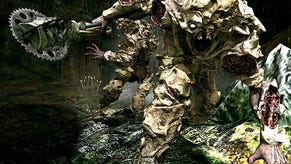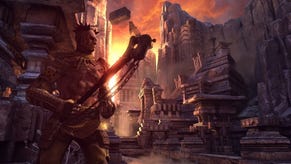id Tech 5
Steve Nix on the growth of id's next engine.
id Software has been synonymous with PC game engines since the concept of a detached game engine was first popularised, and with the launch of each successive round of technology it's been expected to occupy a headlining position.
With Doom 3, that didn't quite go according to plan. The engine - these days referred to as "id Tech 4" - pitched up during a console transition that ultimately saw id cede dominance to competitor Epic Games, whose combination of Gears of War and Unreal Engine 3 sold millions of games and sold licences off the back of them in a manner more accustomed to their great rival.
But if the shortfall in id Tech 4 licensing demonstrates anything then surely it's the fickle nature of the market, and with id Tech 5 the Mesquite, Texas-based developer is keen to right wrongs and regain its crown - if not more. Not only is id Tech 5 a multi-platform solution, but business development director Steve Nix believes it's the cleanest multi-platform solution available; and not only does id claim that it takes as much advantage of the present generation of consoles and PC hardware as anyone is likely to, but it also claims to do away with texture memory limits that often diminish a game's latter-stage graphical fidelity in order to secure frame-rate.
Following id's unveiling of Rage at QuakeCon last Friday, we caught up with Nix to talk about where id Tech 5 came from, what it offers, and what id has to do to get back in the game.
Clearly it's an entirely new rendering solution. It's a massive extension - id Tech 4 with the MegaTexture approach being applied to the terrain is basically the first cut at it. In id Tech 5, all the textures are virtualised on everything - your characters, your buildings, cars, everything. So you have unlimited texture memory, which is huge, because - particularly when you're developing console games - one of the main things you'll see developers getting upset with each other and fighting with each other about is texture budgets, because one guy wants more texture memory for the characters, another guy wants more texture memory for the weapons or the view models, and it's a huge problem.
What happens is, as the game development goes on, you're trying to get your performance to the minimum specs, and you make the game look worse and worse and worse as you get closer to gold. With id Tech 5, with the virtualised texture system, we completely eliminate that. You can lock down the geometry and the gameplay and put a number of artists simultaneously working on the world and they can just make it look better and better and better until finally you're at the point where the game looks as good as you need to ship. It's a huge paradigm shift in the way game developers can work.

Phenomenal. It's funny - we thought it was cool and that we knew what we were doing, but the more we started talking to people about it, their excitement level was so high we were surprised. Their response was, 'Oh my god, are you kidding me? We don't have to worry about texture limits any more? That's a huge breakthrough. That's our number one problem in development.'
I think it was a little more organic than that. I know that when we started working with Splash Damage on Enemy Territory they wanted large, detailed outdoor terrains, and they had some ideas on how to dynamically load the textures and everything, and John [Carmack] said, 'Why don't we try this new approach and make the entire terrain one massive texture, and then just load blocks of texture in dynamically that you can see at any one given time?' So John did the initial work on it, got it up and running, and it just so happened that that work was the basis for what we have in id Tech 5.
I don't know whether or not John would have gotten to that result without id Tech 4 and Enemy Territory, but I know it's something he's been thinking about for a while. I think with id Tech 4 that greatly accelerated us getting to that point in id Tech 5.

I don't spend much time looking at Epic's current offering or what their product line is - we've always just done our own thing at id, so we don't spend too much time thinking about them.
When we look at the competitive landscape, of course Epic's frequently mentioned, and you have other sort-of pure rendering solutions and they have some tools too, but the other competitor we have is people who do in-house development, so if people want to start a multi-platform game they ask themselves - should they adapt and alter technology? Should they write their own technology? So there are a number of competitors in the marketplace, but clearly no one has our virtualised texture solution with MegaTexture, and I'm not aware of anyone who runs as cleanly as we do out of the gate across the platforms - especially not the Mac.
We have the PS3, the 360, the PC and the Mac all running at a very high frame-rate - basically all running at 60fps right now - and what's really unique is that when an artist builds an asset they don't know what they're building it for. They build the exact same model, the exact same level, and it doesn't matter what platform they're putting it on. That's a huge breakthrough. A lot of times you'd have your PS3-optimised assets, your Xbox-optimised assets, your PC-optimised assets, and at the end of the project you'd do this ugly Mac port. If not an ugly PC port. We think that the fact developers can cleanly simultaneously develop all four platforms is a huge change.
From the beginning we had seen that multi-platform was the way to go, and when John first architected this new engine he said it's going to work and have multi-platform, and it was built with that in mind and that's why it works so well. Everything from the fact that you can almost instantaneously get new assets into the game, but also crazy stuff, like an artist can be working on a map and you're driving around in the car and, the next time you come around to that part of the track, in real-time what the artist has just done is there on the walls.
It's an amazing piece of technology. John's sort of assessed where game development was going a few years ago when we started working on this new tech and I think he's really knocked it out of the park. As the guy who manages the technology licensing business, he's made life very easy!
















